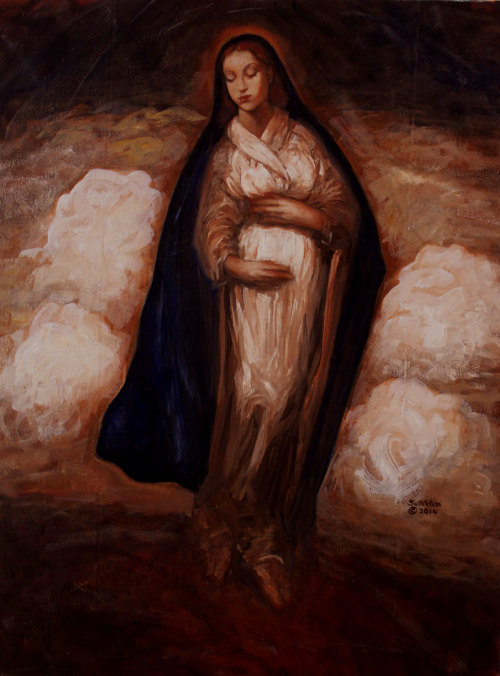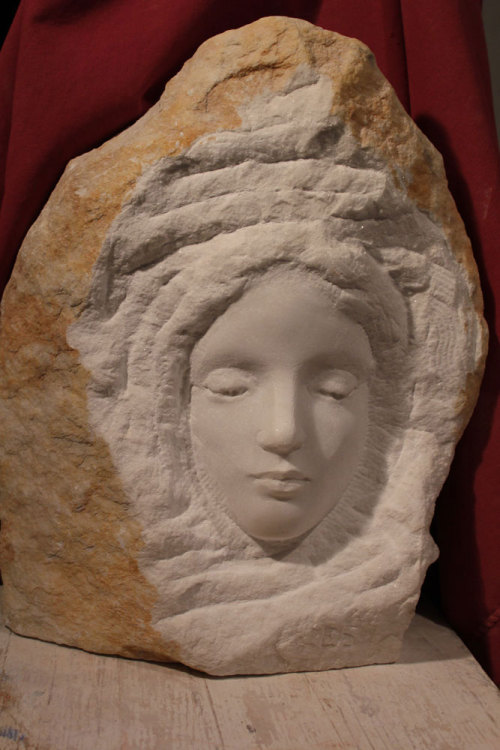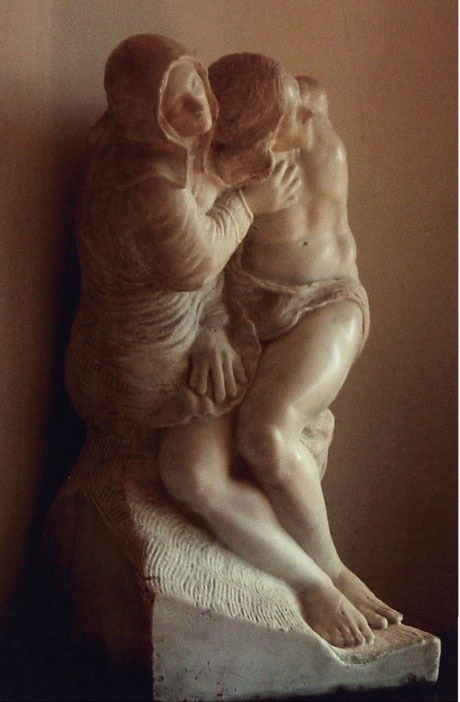Sacred Art Cornelius Sullivan

This photograph was taken in my studio in Gloucester Harbor, Massachusetts. The winter sun was low in the sky and came through a window and reflected off the beveled glass edge of a mirror like a prism and shone on the painting that I was working on. I was startled when I entered the studio. The date was December 8th, the Feast of the Immaculate Conception. It is as if the light is the grace from The Cross pointing out to us The Blessed Mother’s name that she herself has told us.
I made some paintings with the idea that you were there in the crowd, a witness, to these events that were part of Revelation, part of human history.

Descent from the Cross, oil, 16″ x 20″.

Loaves and Fishes, oil, 5 x 8′.

Vision of Saint Michael the Archangel, oil, 3 x 5′, 2011.
In Rome Emperor Hadrian’s Tomb had its name changed since a vision of Saint Michael the Archangel appeared in the sky above the mausoleum. He was sheathing his sword to signify that the Plague of 590 AD would end. The building is now called Castel Sant’Angelo.
The painting is my representation of the vision seen by Pope Gregory the Great and hundreds of pilgrims as they processed from the Basilica of Saint Mary Major through the streets of Rome toward Saint Peter’s Basilica carrying an icon of the Virgin Mary, Holy Mary, Protectress of the Roman People, Santa Maria Solus Populi Romani, believed to have been painted by Saint Luke. Saint Michael dressed in the armor of a Roman soldier, is returning his bloodied sword to the scabbard, signifying that the plague of 590 AD would end. Emperor Hadrian’s Tomb has since been called Castel Sant’Angelo.
The miraculous vision of the archangel was commemorated by a chapel dedicated to St. Michael built atop the mausoleum and later by a statue of the angel placed atop the chapel. Pope Gregory’s vision was never forgotten. It was confirmed by a similar miracle marking the end of the Black Death of 1348.”
Information is from a history of some apparitions of Saint Michael the Archangel at Castel Sant’Angelo from The History and Decoration of Pont S Angelo, Mark Weil, 1974, The Pennsylvania State University Press:
F. H. Dudden, Gregory the Great, London, 1905.



Angel of Plenty, 46″ x 38″, 2008.
Abortion

Abortion, oil on canvas, I had thought that a reason a woman might have an abortion is because the act is hidden. In the painting the mother is turning away and the horse is blindfolded.
About Abortion Pope Benedict has said “We must use our eyes.”


Pieta, marble, 1981.
This work was stolen from a moving van on October 3rd, 1993, in Weymouth, Massachusetts.” Reward , Contact the FBI or Weymouth Police.” Ten years later: Pieta Recovered August 7, 2003. Boston Globe, NAMES by Carol Beggy, August 12, 2003.


Madonna and Child, Carrara Marble, 11 feet high, Conyers Georgia, 1998,
carved in Pietrasanta, Italy.

Madonna and Child, marble, life size, Our Lady of the Holy Rosary Church, Miami, FL.

Our Lady Shelter From The Storm, marble, life size, collection of Our Lady of the Holy Rosary Church, Miami, FL.

Hanging Crucifix, wood, nine feet by nine feet., collection of Our Lady of the Holy Rosary Church, Miami, FL
In his homily at Our Lady of the Holy Rosary Church on September 9th, 2001, Archbishop John C. Favalora said of this corpus, ” His body has become the cross.”

Altar and Crucifix, wooden crucifix, 9′ x 9′, altar is terra cotta panels set into a three ton block of Florida’s indigenous coral rock, 1996, Our Lady of the Holy Rosary Church, Miami, Florida.



Dome of Saint Peter’s Basilica, pencil, 12″ x 17″.

Madonna and Child, pencil, 1982, 11″ x 14″, collection of the Artist.

Double Image, Turin Shroud Head and Crucifixion, ink and wash.
Article published in The Italian Insider Newspaper, Rome. Does God Have a Face? http://www.italianinsider.it/?q=node/3201
Drawing Saint Cecilia

Drawing the Stephano Maderno marble sculpture of Saint Cecilia, Basilica of Saint Cecilia, Rome, 2011.
From Caravaggio, A Life by Helen Langdon, p-162


Santa Cecilia, conte and pencil, 2011, collection of the artist.

Drawing of Blessed Ludavica Albertoni after the marble by Bernnini, San Francisco a Ripa Church, Rome.
Drawings from the Life of Christ Click on the title for a larger image.

Baptism of Jesus by John the Baptist
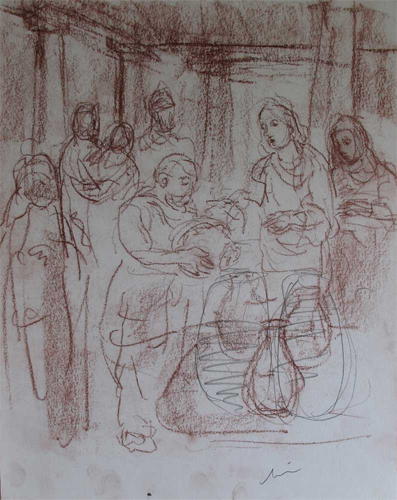

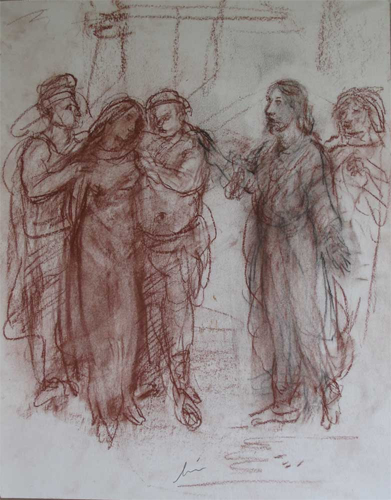
Jesus and the Woman Taken in Adultery

Jesus Washing the Feet of the Disciples
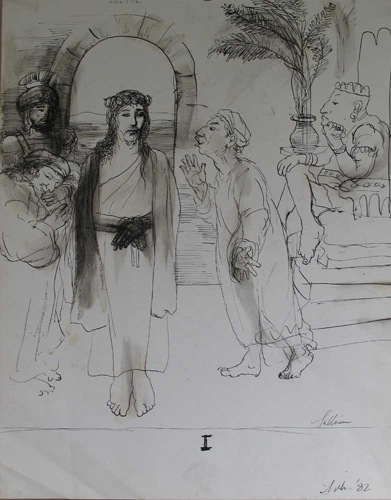

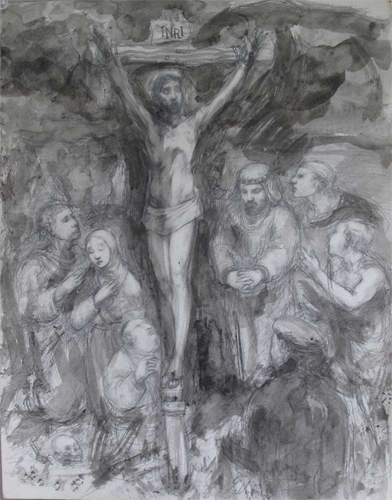

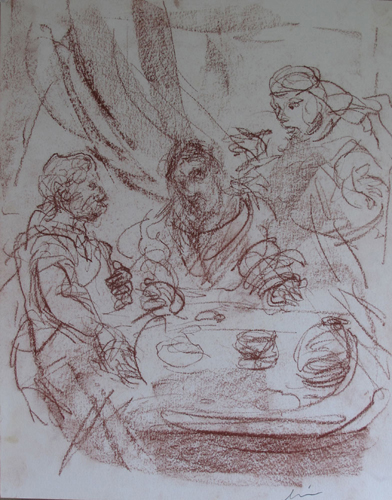

Risen Christ, Saint Zepherin’s Church, Cochituate, Massachusetts, Imperial Danby Vermont marble, black granite, Rosso Levanto Turkish marble, life size, 1992.
As a Traditional Sculptor I was presented with the problem of making an Architectural setting and a sculpture for the new Saint Zepherin’s Church that had the architecture of a meeting hall. I use a Renaissance Marble Carving Method .See my article- Looking over Michelangelo’s Shoulder as He Carves Marble- http://www.corneliussullivan.com/gloucester_lectures.html
The sculpture is part of a permanent Architectural element designed by the sculptor at Saint Zepherin’s Church
I took the shape of the Palladian arch in the architecture of the building and copied that exactly in shaping and cutting the back marble slab. To symbolized the Veil of the Temple splitting I split in two the perfect piece of very expensive Rosso Levanto Turkish Marble with several well placed blows.
The slightly larger than life size head of white marble was perfect for a Risen Christ. It had monumentality from the beginning in the stone. That is reminiscent of Michelangelo’s Neo-Platonist ideas about beauty inside the block waiting to be discovered. I carved a detailed Head of Moses, it had dignity and a presence. I saw beyond that the vision of the Risen Christ and used tools to erase all surface details of Moses with the result looking for an other worldly beauty and mystery. I have been told that the features are perfect. I think that people are allowed to see what they see because the details are not so specific and therefore not limiting. Who wants to see a Photo Realistic Risen Christ? His body was glorified. The letter below by Laura Ferguson a parishioner bears this out. More about that below.
The idea for the finish of the Risen Christ came from a marble Pieta where the Virgin Mary is clear in appearance, detailed, in our world, wheres the Christ has a different look, not so detailed, being in a different place of mystery.
I could not stand the detail and would undo the clarity and go for the mystery again and again. The beautiful marble allowed for that process to continue and indeed always called for more mystery. Doing the same thing for 13 years and expecting different results coincides with Einstein’s idea of insanity. But I did it like an artist, I expected the same results but hoped they would continue to look better. Apropos to carving one sculpture for13 years, Einstein said, “It’s not that I am so smart, it’s just that I stay with projects longer.” Thematically, in this case, it all made sense that the corpus of the Pieta could be on the road to soon be a Risen Christ.
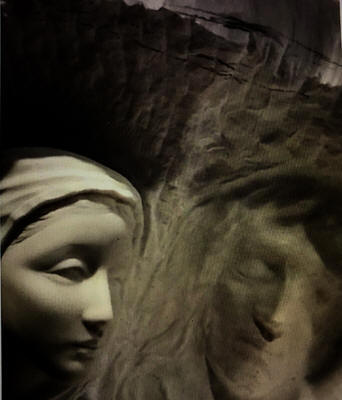
Pieta, Carrara Marble, life size, 2006 – 2018. in process, almost finished.
The Italian sculptor, Medardo Rosso, also in Paris with Rodin and Brancusi in 1906, made his most well known work, Ecce Puer. He put wax over plaster producing a special surface. Apparently he influenced Rodin toward an impressionism (small i) in sculpture.
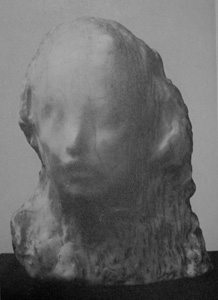
Ecce Puer, Medado Rosso

Before and After, Moses becoming the Risen Christ
The old Saint Zepherin’s was a typical church from the end of the Nineteenth Century with stain glass windows and painted life size plaster statues of saints. They would not be called sculptures. The church was replaced by something that looked like a meeting hall. My marble carving method is a Renaissance one of carving directly on the stone guided by drawings and maybe a small clay model. The commission was to make a Modern work to fit into the contemporary space. In the idea that I had for the Risen Christ I envisioned transforming the Renaissance like detail into something more simple. I had one foot in a Renaissance school of carving and the other in the twentieth century “Direct Carving” school. That is the church that I ran around in as a child and it formed my taste. Content and meaning were paramount.
It was an honor to do this in the church where I was an altar boy for the Latin Mass. I can close my eyes and see statues and the stained glass windows and Stations of the Cross.
My mother and her friend Grace Courchine were the Saint Zepherin’s Altar Society and on Saturday Mornings they would replace the altar cloths and vacuum the rugs as I ran around the pews and studied the art.

http://www.corneliussullivan.com/my_interview_with_saint_peter4.html
He (St Peter)continued, “So to conclude about martyrdom. Do you know that all but two, of the fifty two of my immediate successors as Bishop of Rome are saints, most were martyrs?”
I was proud to say, “I know, someone gave me a piece of paper on the street in 2005 with a list of all the popes. Typed in at the bottom was the name of the new pope. I have kept that list. It is well worn, I will tell you how I used it. Some years ago I did tours of the Vatican Museums. There was another docent who was saying that the museums were all about propaganda and the Church reifying its power. I was not content to read the interpretations of historians of what the place was about. I hoped that I could know for myself the reality behind the grand collection and the buildings. The key was the paper that I had saved. The place is built over the grave of the fisherman, you, and on the blood of the martyrs. When I showed it to visitors they noticed the capital “M”, for martyr, after the names of the first popes, thirty three of them, often in office for a short time. Pope Cornelius made it for three years before he was murdered. I continued, Caravaggio painted many martyrdoms.”

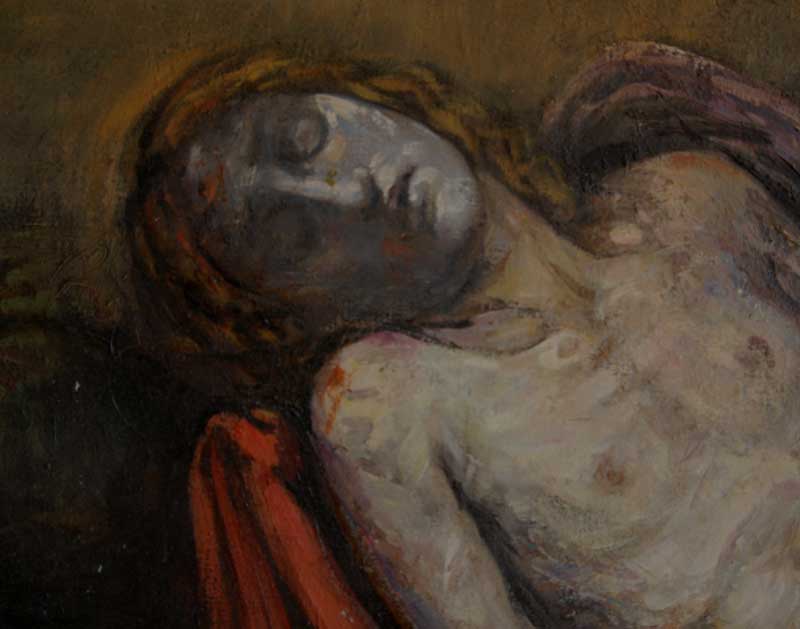

Lamentation, oil, 36×48″.

Lamentation, oil, 36 x 48″, 2012, collection of the artist.

Last Supper
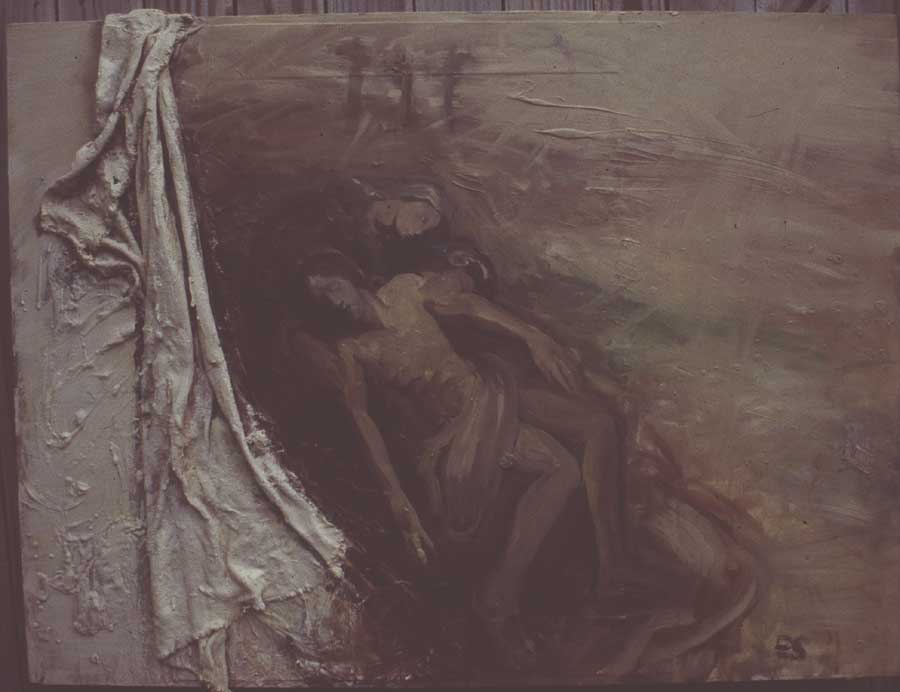
Pieta with Shroud

Christmas Painting, oil, 40″ x 40″, private collection Cuba, New York.
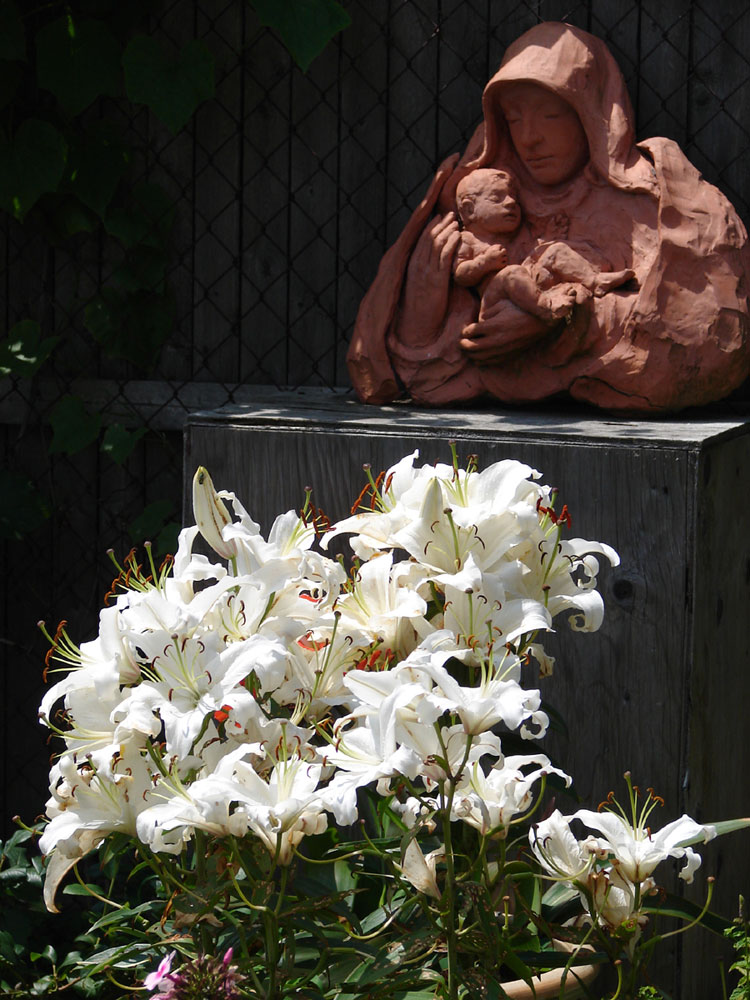
Madonna and Child with Lilies
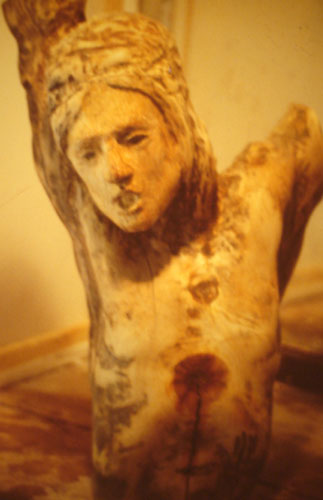
Crucifix, wood, 24″ high.
Gethsemane, oil, 16×20″, 200

Saint Jerome, terra cotta study for marble, 19″ high.
Proposal for a large marble for Sant Jeromes Church, Fort Lauderdale, FL.
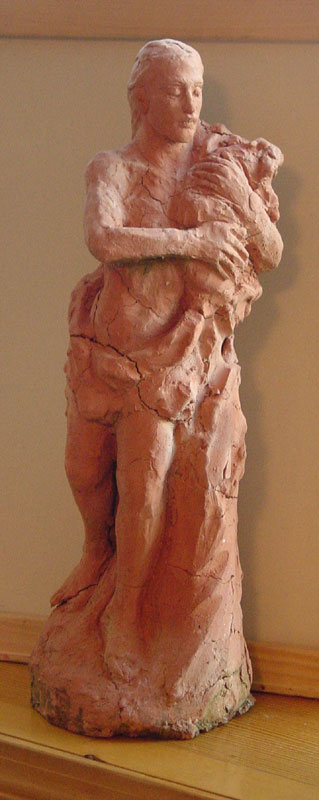
The Good Shepard, terra cotta study for marble, 22″ high.
Proposal for a large marble for Good Shepard Church, Kendall, FL.
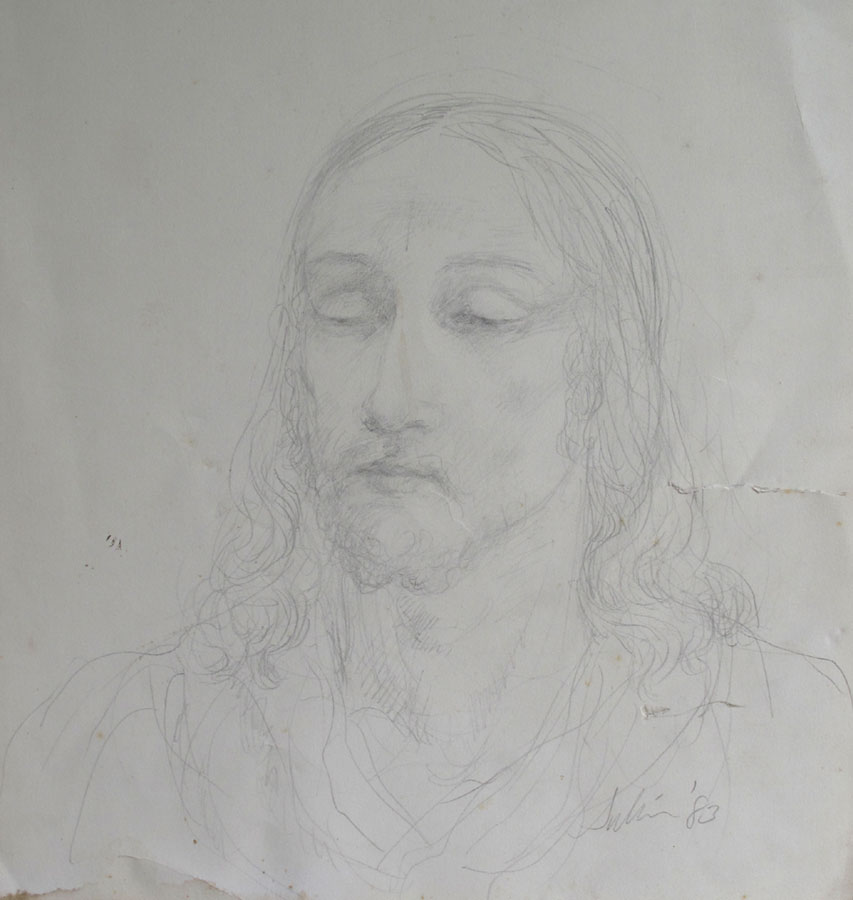
Head of Christ, pencil.

Bronze Angel. I learned that Ancient Greeks used marble molds carved in reverse for casting bronze.
This was done as an Artist in Residence at the Rhode Island School of Design Foundry.
 Exhibit: The Sacred Art of Cornelius Sullivan
Exhibit: The Sacred Art of Cornelius Sullivan
E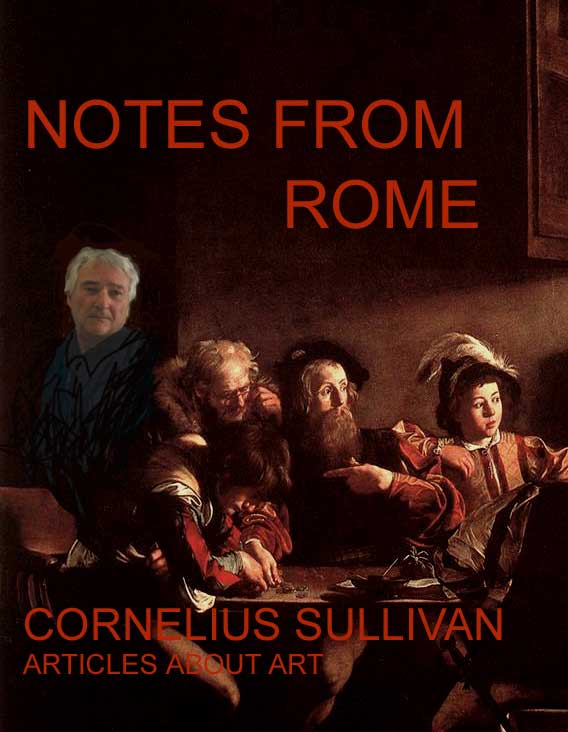
Looking over Michelangelo’s Shoulder as He Carves Marble
Papa Wojtyla as Capeman Sculpture of Pope John Paul II by the Train Sation, Rome June 30, 2011 “Erudite”-J. P.
CARAVAGGIO
Caravaggio Speaks to the Modern Age June 20, 2012
Caravaggio’s Raising of Lazarus
Who is Saint Matthew for Caravaggio
Rome’s extravagant celebration of Caravaggio- How can we know another man’s death.
Caravaggio, Saints and Sinners- Caravaggio painted sinners as saints.
Caravaggio, the most Unlikely Candidate
Caravaggio on the Run in Malta
Interview with Saint Peter, the Art of Martyrdom November 3, 2012
Attacks on Caravaggio I saw him there in the street, the narrow street, Via del Leone, June 4, 2012
Caravaggio Reveals Himself- The most unlikely candidate August 3
Caravaggio and the Marilyn Elvis Syndrome- Only the good die young. July 25
Caravaggio and the Aesthetics of Meaning- Caravaggio is the antidote to Conceptual Art. September 27,
Caravaggio, Rembrandt, and Vermeer, not just realists- Caravaggio used light to tell the story. September 6
Who is Saint Matthew for Caravaggio August 7, 2012, revised June 2, 2018
Another Bogus Caravaggio Discovery July 10, 2012
Tranquillo Caravaggio, the Town June 26, 2012
Caravaggio Borrows from Michelangelo December 18, 2011
MICHELANGELO
Michelangelo in Rome November 15, 2011
Carving Marble by the Michelangelo Quarry in Carrara Summer 2014
A Lost Michelangelo, don’t get your hopes up July 18, 2012
SACRED ART
Sacred Art and the Theology of the Body, Caravaggio, http://www.italianinsider.it/?q=node/2843
Sacred Art and The Theology of the Body, Part One, Caravaggio related- Exhibition at Ave Maria University, 2015,
ART CRITICISM
The first article published by The Italian Insider Newspaper-
Capeman II: Papal Statue not Improved November, 20, 2012 “Well said”.- M.P., “Great Article”-C.S., P.A.
Rev. Martin Luther King Jr. as Mao February 2012
Art Mysteries Solved, a Leonardo, a Michelangelo, and a Raphael October 11
Moor Fountain in Piazza Navona vandalized
Does God Have a Face? http://www.italianinsider.it/?q=node/3201
Sacred Art and The Theology of the Body
OTHER
American Views of the Amanda Knox Verdict November 3
The Roman Forum June 8, 2012
March 23, 2016 I wrote this short piece yesterday for John and Ashley in Rome who produce Voice of the Vatican,
for a TV video they are shooting today. Crucifixion with Saints, Pietro Perugino
all content copyright Cornelius Edmund Sullivan 2020

